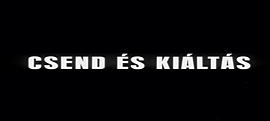 Csend és kiáltás
Csend és kiáltás
Hungary, 1967, black and white, 76 mins
Both made and set in the same year as The Red and the White (Csillagosok, katonák) – 1967 and 1919 respectively – Silence and Cry returns to the puszta – that great flat Hungarian plain stretching out to infinity – that Miklós Jancsó made such an indelible part of The Round-Up (Szegénylegények, 1965). Although much more of a chamber piece than its two immediate predecessors (there’s just one primary location, and only a handful of characters), it nonetheless pushes Jancsó’s fascination with landscape and long, sustained takes to new extremes, even to the point of replacing his regular cameraman Tamás Somló with János Kende, because the latter was more willing to attempt logistically complex 360-degree pans.
Unlike the spoken or written introductions to The Round-Up and The Red and the White, the only scene-setting here consists of a montage of photographs set to a monophonic melody played on an ancient piano that’s attempting (sarcastically?) to mimic a triumphal brass fanfare. The man featured in most of the photographs (though no indication of this is made in the actual film: Jancsó clearly assumes that a Hungarian audience would recognise him instantly) is Admiral Miklós Horthy, who had just triumphed over the pro-Bolshevik forces led by Béla Kun, setting in train a fascist regime that would remain in place for another two-and-a-half decades.
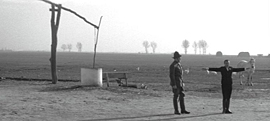
The opening scene, set on a sand dune, shows Kémeri – played by Zoltán Latinovits, the lead in Cantata (Oldás és kötés, 1963) – disposing of a Kun supporter in a manner not dissimilar to the out-of-the-blue executions in Jancsó’s two previous films, though in this case Kémeri does at least have the decency to dig a grave. He also has the decency to discipline Kanyasi, one of his underlings, for going too far in his treatment of female civilians, something that wouldn’t have happened in the far more dispassionate The Red and the White.
More significantly, he deliberately turns a blind eye to the film’s other male protagonist, fugitive Red soldier István (András Kozak, another familiar Jancsó face), even though he’s nominally in charge of local affairs – he even prevents a search of a haystack from going ahead, as he knows this will betray István’s whereabouts. The reason for this is never explained, though there are hints that the two previously knew each other when Kémeri makes a casual (and rebuffed) offer of a drink. On the other hand, it could be because Kémeri has a psychological need to assert himself over a younger, more attractive man – in a subsequent conversation with István, he emphasises how dependent he is on his goodwill, and that he could have him shot at any point. He also takes a perverse delight in piling regular humiliations on the farmer Károly (Jószef Madaras) for little apparent reason, often with the collaboration of his men.

Most of the film takes place in Károly’s farm on the puszta – it’s not unlike the one in the final scenes of Cantata. Károly’s wife Teréz is played by Mari Törőcsik, the iconic lead in Zoltán Fábri’s Merry-Go-Round (Körhinta, 1955) and, shortly after this film, Károly Makk’s Love (Szerelem, 1971). Her calm demeanour conceals a deadly secret: while openly sharing István’s favours between herself and her sister-in-law Anna (Andrea Drahota), she is slowly poisoning Károly and his mother. When István finds out, he is put in a moral quandary, since it would be impossible to report them to the police without revealing his identity and whereabouts.
But any fleeting impression that this film is a conventional domestic love-triangle melodrama is comprehensively undermined by Jancsó’s treatment. The takes are longer than ever (there are apparently fewer than forty shots in the entire film), the camera perpetually circling around his endlessly pacing characters, constantly reframing them against the landscape with its sparse outcrops of trees and haystacks and thatched white buildings. Dialogue is purely functional, gestures only occasionally revealing – since these are often carried out at a distance from the viewer, it’s not always easy to interpret them at first glance. (Teréz’s mask-like face is particularly inscrutable as she strolls calmly past a violent confrontation between István and her sister-in-law).
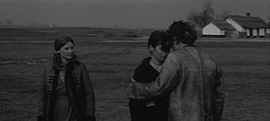
On the soundtrack, Jancsó’s characteristic birdsong can still be heard, but it’s often usurped by the harsher sounds of crows and cockerels, and also by a near-ubiquitous wind, which serves to chill even occasional romantic encounters to the marrow – though the word ‘romantic’ seems singularly inappropriate when applied to the scene where István is passed from Teréz to Anna, and finally neglected as the two find greater intimacy with each other. The fact that it takes place in the open air shows their essential contempt for Károly’s opinion.
So for all the apparently smaller, more human scale of this film, Silence and Cry is of a piece with its immediate predecessors in that it’s ultimately an exploration of hierarchies of power, whether national and wide-ranging (Horthy), local and circumscribed (Kémeri) or domestic and subversive (Teréz). These hierarchies are tacitly acknowledged even by their victims: Károly seems unconcerned about his fate, Teréz and Anna regard István’s threat to expose them with sphinx-like equanimity, and István himself accepts that with only one bullet in his gun at the end and several armed witnesses, shooting Kémeri will provide only the most fleeting satisfaction – though Jancsó extends this by means of an enigmatic closing freeze-frame. Incidentally, this is the third of four films to end with András Kozák looking directly at the camera, as if trying to communicate with an audience that he has ignored up to then.
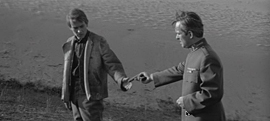
Silence and Cry was the last of Jancsó’s black-and-white Scope films, marking the end of one of the most distinctive lines drawn by anyone in 1960s cinema. His next film, The Confrontation (Fényes szelek, 1968 – only available on an unsubtitled Hungarian DVD at the time of writing) would be his first in colour, and would mark the start of a new phase in his career.
- Director: Miklós Jancsó
- Producer: Lajos Kiss
- Screenplay: Gyula Hernádi, Miklós Jancsó
- Photography: János Kende
- Production Design: Tamás Banovich
- Costume Design: Zsuzsa Vicze
- Editor: Zoltán Farkas
- Sound: Zoltán Toldy
- Cast: Mari Törőcsik (Teréz); József Madaras (Károly); Zoltán Latinovits (Kémeri); Andrea Drahota (Anna); András Kozák (István); István Bujtor (Kovács II); Ida Siménfalvy (Teréz’ mother); János Koltai (Peasant); Sándor Siménfalvy (Old peasant); Kornélia Sallay (Auntie Veronika); János Görbe (The shepherd); László Szabó (Detective); Philippe Haudiquet (Photographer); Mari Boga; Károly Eisler; Mária Goór Nagy; Ferenc Kamarás; Miklós Köllő; József Konrád; Zsolt Körtvélyessy; Ila Schütz; Sándor Szili; Tibor Talán; Sándor Vajó
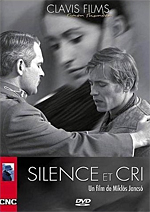
DVD Distribution: Silence and Cry is distributed by 21st Century Dreamquest (US, NTSC), Clavis Films (France) and Mokép (Hungary) – the latter are both PAL, but the Mokép disc has no subtitles. This review is of the Clavis version.
Picture: Sadly, the image is almost as soft as the one on Second Run’s The Red and the White, and interiors tend to be swallowed up in shadow. While it’s impossible to be certain of this without reference to a Jancsó-approved 35mm print, the picture also seems on the dark side, and the non-anamorphic transfer doesn’t help matters. It’s a pity, because the source print is otherwise very clean, and appears to be framed correctly in the original CinemaScope.
Sound: The sound is on a par with Clavis’ Cantata, in that there’s continuous background hiss and occasional crackle, but it’s easy enough to tune out. However, it’s distinctly inferior to the virtually flawless soundtracks of Second Run’s The Round-Up and The Red and the White.
Subtitles: As usual with this label’s Jancsó releases, optional French and English subtitles are provided. The latter are yellow, and not 16:9 friendly, the latter a by-product of being kept outside the film frame. They generally do a decent job, though there are more typos (‘Undoo your shirt’) than there were on Cantata, and on two occasions a French subtitle pops up by mistake. Another minor irritation is that two-line subtitles often translate dialogue uttered by two characters, without a visual indication of a change of speaker – though the translation as a whole seems thorough enough.
Extras: The only extras are a short Jancsó biography and filmography, both in French.
Links
- Filmtörténet (in Hungarian, but with video clips)
- Internet Movie Database
- Kinoeye’s excellent overview of Jancsó’s 1960s career briefly mentions Silence and Cry, as does their interview with the director. The film is discussed in more detail in a separate piece about his fondness for the year 1919.
- Clavis Films’ page about their DVD (includes video clip).
- Clavis DVD available from: Amazon.fr; Fnac, Alapage